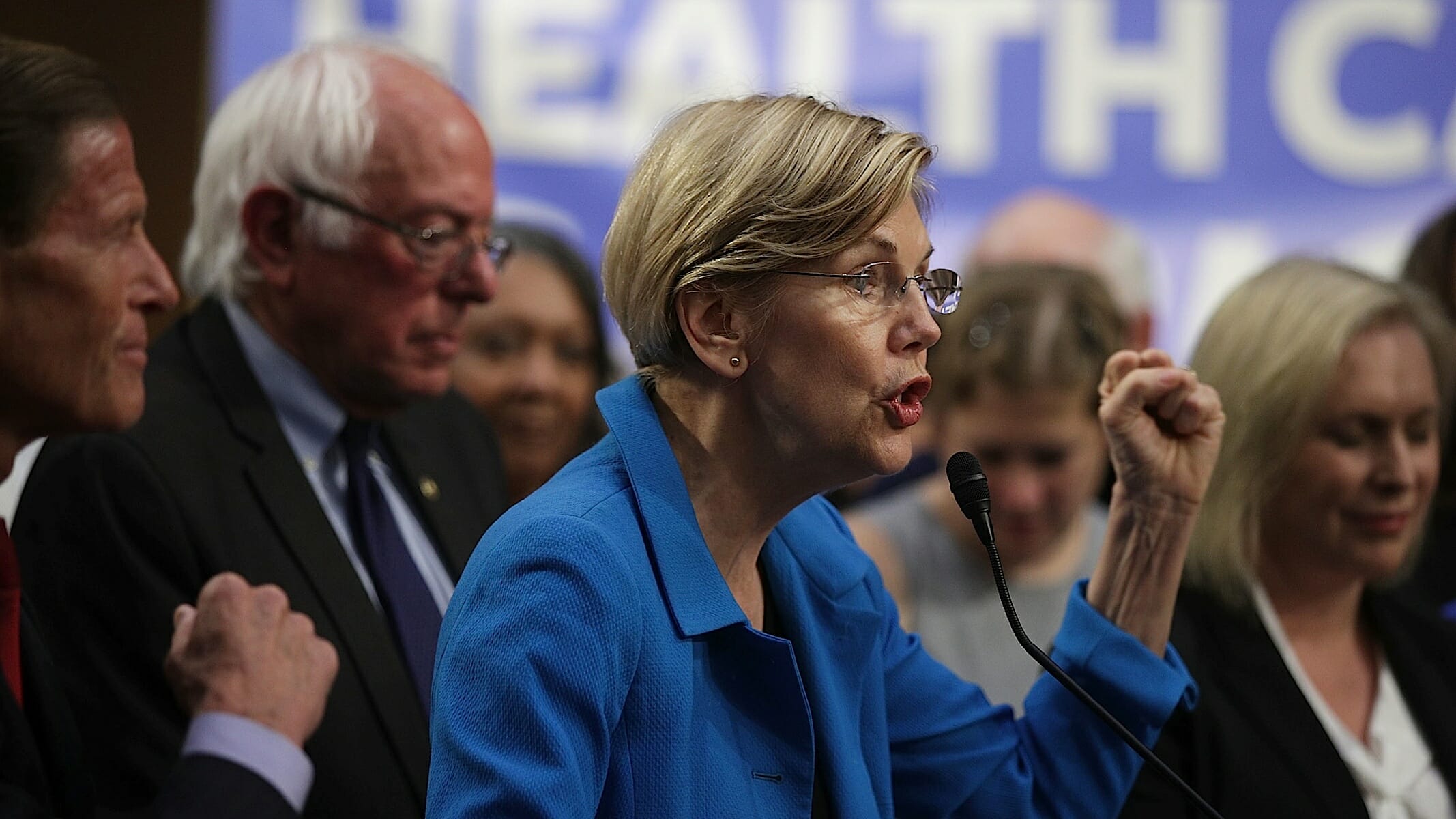What Exactly IS Medicare for All?
Looking at a complicated institution rapidly gaining support among Democrats and Republicans
Photo by Alex Wong/Getty
The early Democratic primary is strewn with progressive litmus tests, a minefield that resembles the North Sea in that as time goes on seemingly more and more are uncovered. Socialism. Reparations. Free trade. Military intervention. Gun bans. Abolishing the Electoral College. PAC money. “Packing” the Supreme Court. Impeachment. The Green New Deal. Free college tuition. And perhaps the most hotly debated and closely watched among voters, Medicare for All.
But just as importantly, these issues are minefields in themselves. Though often presented as binary questions—”Are you for or against X?”—that oversimplified framework does a disservice not just to the candidates but to voters trying to educate themselves on complex issues where each nuance presents candidates with different paths forward. Further, in a country as hopelessly divided as the United States, the binary test ignores the reality that unless Democrats win not just the Presidency but the House and Senate as well—the odds don’t look good—it’s not likely any Democratic candidate who passes the litmus tests will be able to pass litmus legislation by Mitch McConnell.
This isn’t an argument that candidates and voters shouldn’t go to the mat to fight for core progressive ideals, or that progressives should forgive candidates who take positions antithetical to core progressive ideology, but that “core progressive ideology” is itself a mercurial concept increasingly defined not as a shared collection of ideas or values—ends in themselves—but, somewhat ironically, as the means someone believes is the best way to achieve those ends. The litmus tests, then, only make sense if you believe these issues aren’t complicated, and offer only a few truly “progressive” paths forward. The result: In the first weeks of the 2020 primaries massive fault lines have already appeared along what were at one time relatively minute differences, creating rifts between candidates and liberal voting blocs who in the end want (often, but not always) the same things.
There’s no better poster child than Medicare for All.
THE TWO FACES OF MEDICARE FOR ALL
Medicare is a government-run program that provides insurance to Americans 65 and older. In short, “Medicare for All” (M4A) would extend that existing plan to all Americans. Synonyms for this plan and similar ones—some more squishy than others—include “universal coverage,” “socialized medicine,” “single payer,” and “a public option.”
There are essentially two versions of M4A. The first (best exemplified in Bernie Sanders’ recent bill, co-sponsored by Democratic candidates Cory Booker, Kirsten Gillibrand, Kamala Harris, and Elizabeth Warren) is a “single-payer” (government-provided) system, which, as currently articulated, would eventually (virtually) eliminate private insurance. This bill folds all Americans under one government plan, meaning we’d all have the same insurance, including theoretically all of the 8.8 percent of currently uninsured Americans. (Fairly amazing that Obamacare, flawed as it is, still got the insured rate higher than 90%—as measured by people who had insurance of some kind at some point within the calendar year 2017.)
Another version of M4A isn’t universal coverage, but universal “access.” Any American who wants to buy into Medicare can access that option if they want it. Under this framework, some Americans might choose not to buy in—or, given possible costs or coverage options, possibly not be able to afford it—and they’d go without insurance. But this plan itself has two versions: The one just mentioned, and one that Democratic hopeful Pete Buttigieg calls “Medicare for All Who Want It”: Americans who like their current private plan wouldn’t be forced to take a government plan, which might not offer the same breadth of coverage.
Third is a government plan that doesn’t cover everything, but leaves certain services to private providers. All countries with “socialized” medicine run it this way. For instance, England’s government plan doesn’t cover dental insurance. If you want it, you have to buy it from a private provider. The Canadian system leaves home health services, prescription drugs, and dental and vision care to the private sector. Other countries have similar layouts, such as the Netherlands, which doesn’t include dental and vision. In Sweden, private companies cover around 20% of public hospital care, as well as 30% of public primary care. (Candidates such as Buttigieg, Amy Klobuchar and, far as we can tell, Joe Biden support plans that look something like these last two versions.)
And that will be the major sticking point: Do Americans want a healthcare system that mandates everyone accept government coverage, or do they want one that allows them to keep what they’re already paying for? And if we frame it as a progressive litmus test, is one plan more progressive than the other?
At its most essential, Medicare for All (M4A) is a progressive policy: In extending the human right to healthcare to all Americans it guarantees broad benefits even to the least privileged among us, it doesn’t discriminate, and healthcare providers don’t fleece anyone. If we go by that definition, the above versions that guarantee everyone broad government coverage qualify, regardless of options for private coverage.
With these models in mind, what does today’s version of M4A look like?
THE SANDERS PLAN
Sanders’ plan, however, is incredibly generous. In terms of benefits, it has no equal, even in countries with socialized medicine. The 2019 M4A Act would cover primary care, hospital visits, maternity care, lab work, medical devices, dental, vision, long-term care, rehab, and prescription drugs (though some prescriptions would be out-of-pocket). It eliminates all out-of-pocket healthcare spending, with the prescription drugs exception. You won’t pay when you go to the doctor or emergency room. You won’t pay premiums. There won’t be deductibles. Amazing.
As a result, there wouldn’t be much elbow room for private insurance, and the industry would likely all but vanish. However, the Sanders approach doesn’t immediately eliminate private insurance—or even eliminate it altogether. The M4A Act accounts for a four-year “transition period.” In that time, per the bill, anyone eligible for M4A benefits “may opt to maintain any coverage described in section 901, private health insurance coverage, or coverage offered pursuant to subtitle A of title X.” In other words, anyone can keep whatever plan they want during the four-year transition to a single-payer government system. So that’s “working with insurance companies,” even if for a time.
Further, though the Act prevents private health insurers and employers from selling coverage that duplicates government benefits, it also makes clear that ”[n]othing in this Act shall be construed as prohibiting the sale of health insurance coverage for any additional benefits not covered by this Act, including additional benefits that an employer may provide to employees or their dependents, or to former employees or their dependents.” In other words, there might indeed be some room for private insurance to pick up things the government doesn’t, even when the plan is in full swing.
These details make it tough to talk about M4A on the campaign trail, even for someone who supports it—or perhaps especially for someone who supports it. If you ask Sanders, Harris, Booker, Gillibrand, or Warren if they support Medicare for All, they can say, “yes”—because they’re on record as co-sponsors of the M4A act. But that “yes” also covers the caveats of that act, and when you drill down to the details it might even appear hypocritical. On one hand the M4A Act honestly will do its best to eliminate private insurance, but at the same time the plan itself also recognizes things really might not shake out that way. For instance, it leaves open a possible future role for private insurers to offer boutique supplementary coverage. The Act also acknowledges that individual states themselves will unavoidably find wiggle room: “Nothing in this Act shall prohibit individual States from setting additional standards, with respect to eligibility, benefits, and minimum provider standards, consistent with the purposes of this Act, provided that such standards do not restrict eligibility or reduce access to benefits or services.”
Case in point, the confusion generated from an answer Kamala Harris gave at a CNN town hall this January, in which she seemed to say she wants to “get rid of” private insurance, but which she was forced to clarify the next day, because the plan she supports (again: the Sanders plan) does in fact account for some role private insurance might or might not have in the future. This isn’t Harris showing her “true” centrist colors. This is the paradox generated by our oversimplified understanding of M4A in the first place. The truth, of course, is that no candidate can honestly say this plan will eliminate private insurance. If it does, great. But it’s not all-or-nothing: There are caveats, and even if M4A passed today, it recognizes the future role for private companies (possibly nationally, and possibly empowered by decisions at the state level) isn’t yet certain.
WHAT’S TRULY PROGRESSIVE ABOUT MEDICARE FOR ALL
If the universal human right to healthcare is our shared progressive goal, we have to figure out how to get from where we are to where we want to be. We can’t clap-our-hands-say-yeah M4A into existence.
In 2003, Barack Obama, describing a future landscape similar to that promised by M4A, said:
I happen to be a proponent of a single-payer universal health care program. I see no reason why the United States of America, the wealthiest country in the history of the world, spending 14 percent of its gross national product on health care, cannot provide basic health insurance to everybody. And that’s what Jim is talking about when he says everybody in, nobody out. A single-payer health care plan, a universal health care plan. That’s what I’d like to see. But as all of you know, we may not get there immediately. Because first we’ve got to take back the White House, we’ve got to take back the Senate, and we’ve got to take back the House.
Five years later, Democrats won the White House, the Senate, and the House. Obama tried to push through his single-payer, universal plan, and was blocked not by Republicans, but by Senators in his own party. The party wasn’t ready—let alone the country—and faced with the choice between nothing and something, Obama led Democrats in a lengthy negotiation process that resulted in the Affordable Care Act.
True, liberals have moved to the left, and hardly anyone in the party doesn’t want to push for some version of a universal plan. When you look at recent bipartisan polls, however, you’ll see the story is more complicated—and the M4A bill’s nuances reflect that complexity. Which lead us to think the country is in a different place now, but then again, it might not be. Recent polls reliably and repeatedly show that about seventy percent of Americans—not just Democrats—support universal healthcare. But nearly the same amount—around 65 percent of all Americans—supported a single-payer system in 2009, when Obama took office.
A recent Kaiser Family Foundation survey (NOT the insurance provider; a foundation that conducts regular national surveys about healthcare) found that 56 percent of Americans support “a national health plan, sometimes called Medicare for All.” And even more sanguine 71 percent support a program that would “guarantee health insurance as a right for all Americans.” But when asked about the costs of single-payer systems, M4A support dropped fairly dramatically to less than 40 percent. The prospect of a future plan that would do away with private insurance and pay for it through higher taxes (as Sanders’ would) knocked support to 37 percent, and if such a plan meant possible delays in treatment, support dropped to 26 percent.
In other words, it’s complicated, and any Democratic President pushing a M4A plan—especially one such as the Bernie bill now on the table, which could cost $32 trillion over a decade—will have to appeal not just to the shared belief that all Americans have the right to healthcare, but make a convincing argument about—yes—how we get there, and how we pay for it. Sanders himself, though he’s offered specific suggestions, isn’t yet clear about his plan to pay for it. And sure, the dream is good, but a President will have to sell it. (Sanders, in nearly thirty years in Congress, has gotten seven bills passed into law.)
The progressive critics’ buzzword “incrementalism,” therefore, is absurd: Any policy roadmap is tautologically incremental. Though the four heinous years of a Donald Trump presidency and GOP control might indeed have created a unique opening for the left to appeal a winning “now or never” argument for what were once considered radical non-starters, as long as Democrats have to contend with a Republican Senate they must also cede that no policy ambitious enough to earn the “truly progressive” seal will be achieved at the clap of a President’s hands, even—as Democratic courtroom challenges to Trump’s most extreme orders have shown—via executive fiat. For instance, would the conservative Supreme Court—which only narrowly upheld Obamacare on a technicality—agree not just that healthcare qualifies as a “national emergency,” but that the immediate implementation of a universal plan is constitutional?
Sadly—or maybe not so sadly for voters concerned about limitless expansion of executive power—that’s not our reality, and even the most aggressively progressive policies recognize this: They’re all “incremental.” All M4A plans on the table are paths, not commands.
We must therefore shift the progressive litmus test about M4A or other universal plans to be primarily about the ends: Will all Americans be cared for, even those who can’t afford to pay anything? Will no one get fleeced in the process? If so, any such plan should pass the progressive test and move on to round two: How will we get there?







































